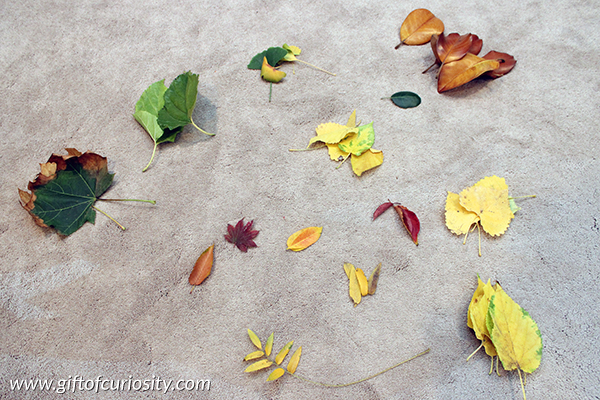This post may contain affiliate ads at no cost to you. See my disclosures for more information.
Perhaps the most enduring symbol of fall is the changing colors of the leaves on the trees. In our area, the leaves generally don’t begin changing color much until at least late September, but sometimes not even until late October. Last year we collected a number of beautiful fall leaves, and we thought it would be fun to try different ways of preserving them.
The trouble was figuring out what the best way to preserves leaves is! I read about several different methods online. Ultimately, we decided to test out three different methods for preserving leaves to see which method we liked best.
Note: For more leaf activities, see my Botany Unit Study page.

Our whole adventure started with a trip to a local park where were collected a nice variety of fall leaves. We then sorted the leaves by type. We took one sample of each type of leaf to use with each of our three leaf preservation methods.

Method #1: Preserving leaves through lamination
The first method we attempted was to preserve the leaves by laminating them. I pulled out our awesome home laminator and a bunch of laminating pouches. I placed as many leaves as would fit into each laminating pouch and ran it through the laminator. The laminator struggled a bit with some of the stiff and bumpy leaves, but otherwise handled the job fairly well.
I then cut around the leaves, leaving a bit of laminating plastic around each to maintain a seal around the leaf.
We generally liked the results. The leaves were shiny and smooth from the plastic. They felt very sturdy, like they would hold up for a long time. However, by laminating them they lost some of their “leaf” feel, since they now felt like plastic instead of leaves. Some, but not all, of the leaves also discolored from the heat of the laminator machine, very quickly turning a dark brown.

Method #2: Preserving leaves with wax paper
In an attempt to preserve the leaves with wax, I placed the leaves between two sheets of wax paper and we ironed them between a towel. (Note: an adult should carefully supervise if children are allowed to use the iron. Use good judgement when deciding whether your children are ready to use an iron.)

We ironed and ironed and ironed for what seemed like a very long time, but never got the results we had hoped. There were problems regardless of whether we left the wax paper on or took it off.
Leaving the wax paper was not appealing because the color of the leaves was so muted by the wax paper. Plus, the wax paper didn’t hold together well like the laminating pouches, but just started falling off the leaves. However, taking the wax paper off the leaves didn’t seem to work either, since when we took the wax paper off it was clear that very little wax had transferred to the leaves in order to preserve them.
So this method was a bust for us. But I’ve read that it has worked for others. Maybe we just had a bad brand of wax paper?

Method #3: Preserving leaves with glycerin
The third method we tried was to preserve the leaves with glycerin. I placed a handful of leaves in the bottom of a container. I then added enough glycerin to cover them. I put another container on top and weighed it down with a jar in order to ensure the leaves would stay submerged in the glycerin.

We left the leaves in the glycerin for a week. It may be possible to leave them in for less time, but based on information I’ve read online I would recommend leaving them in for at least 3 days. When we removed them from the glycerin, we placed them on paper towels to let them dry.
We were generally pleased with the results. The leaves maintained a more natural feel. They remained pliable and had their regular texture, unlike the laminated leaves. Some of the glycerin-preserved leaves became discolored soon after they were removed from their glycerin bath.

Best way to preserve leaves: The results
After our experiment with finding the best way to preserve leaves, the kids and I discussed our results.
XGirl like the laminated leaves best, as she enjoyed the very glossy feel. She also liked how sturdy they were.
QBoy, on the other hand, preferred the glycerin soaked leaves for their more leaf-like feel.
I found benefits to both methods. The laminated leaves were very sturdy, and might work best if the leaves were to be used in any capacity in which the kids could be rough on them. The glycerin leaves, however, definitely felt more natural, so would be best when a more natural feeling leaf was desired.
We all agreed that the wax paper leaves did not work.

One year later
One year later, both the glycerin and the laminated leaves continue to be in good shape. I had wondered how much decomposition would take place, but both the laminated leaves and the glycerin-soaked leaves continue to look virtually as they did when we did this experiment one year ago.

For more information about preserving leaves, see:
- How to preserve leaves from Buggy and Buddy
- Preserving leaves from Home Training Tools
More resources for learning about leaves
More leaf posts from Gift of Curiosity:
- The best way to preserve leaves
- Leaf anatomy
- How leaves “breathe”: A transpiration demonstration
- How leaves get water
- How and why leaves change color in the fall
- Leaf collages art project
- Leaf rubbings activity book
- Fall leaves Sudoku
- Fall leaves lacing cards
For more leaf activities, see my Botany Unit Study page and my Leaves Unit Study Pinterest board.
Follow Katie @ Gift of Curiosity’s board Unit Ideas: Leaves on Pinterest.
Products mentioned in this post:




My mom (who is a 1st grade teacher) was just looking for a way to preserve leaves well, I’m going to pass this on to her! Thanks for sharing!
Dudes…
I did a project back in 4th grade…a collection of leaves.
I went around my neighborhood and collected and organized leaves…
I used the wax paper method. This was some 30 years ago. I still have that leaf collection ( I just dug it out because my daughter wanted to start her own)!
It is not in the greatest shape, but wax paper works! For many years, the leaves were well preserved and vibrant. You just have to know how to do it properly…
I have a laminator, but for the life of me, I can’t understand the reasoning of spending so much to laminate leaves. Wax paper is SO much less expensive and easier to do. Glycerin is good, but it requires you to buy something that you wouldn’t use anywhere else. With wax paper, you have it for baking so there is no waste!
I know that wax paper has worked well for others. We just couldn’t get it to work for us. Maybe our wax paper wasn’t any good? I don’t know. But that’s pretty incredible to hear that you still have wax paper preserved leaves from over 30 years ago!
Unfortunately I think they have changed the way wax paper was made from many years ago. I had the same experience as you. It did not work at all for me.
Also the glycerin turned most of the colored leaves dark brown or black, so that didn’t work for us also. Maybe we had the glycerin/water ratio off but I had read somewhere else that this changing of colors is common for certain types of leaves.
Do not use a towel to iron leaves in wax paper method as towels are too thick. Sandwich leaf packet between two sheets of typing paper instead. I did my leaf book in 6th grade and it still looks good and I am 65 now. Do not recall if I pressed the leaves in a heavy book beforehand or not.
Thank you for the tip!
A year later were the glycerin leaves still:
the same color?
pliable?
I believe they were a bit darker but still very pliable.
Hi there! This was great to read. We collected today on a whim to make some fall placemats, and im doing a little research before I start. I’m planning to use my laminator (any excuse to use it gets me excited!). Do you need to press or dry the leaves first? I’d rather try to preserve them as quick and natural as possible to avoid color changes. Thanks for the help!
I did not press or dry the leaves before laminating. So give it a try!
Thx!
Excellent post. Thanks for sharing this. I especially appreciate the 1 year follow up. Just aweome. You rock.
Excellent post. I am a 5th grade teacher and run a Junior Naturalist program and environmental programming at our school. I was looking for ways to preserve leaves for students to look at on a hallway board. I was thinking of laminating them, but was wondering how they would hold up. Now I know! I really appreciate your one-year-later update. How are they holding up now?
We moved a couple of years ago and threw them out when we moved, so I can’t answer your question about how they are holding up this many years later. 🙂
Which model laminator in the photo?
This is the laminator we own: https://amzn.to/2YTul9D
Hi Katie, This might be of interest to you, and will probably sound unbelievable. Guessing a bit here but early 1900’s a friend of my Nan’s in the UK ,either sent her or brought back for her a leaf from Table Mountain. I have this leaf. It was written on both sides. One side stating where it came from. I am guessing it was preserved using the glycerin method. Sadly the writing is starting to fade, and the leaf possibly has also faded some.but it is still very soft and in one piece. I hope to find a way to keep it from deteriorating but don’t want to permanently cover either side.the second side has a brief personal message on it. Anyway it’s amazing it has kept so well for so many years. Thank you for sharing your experiments. Sonia.
Amazing!
Wonderful… You explained everything in detail and made it look so simple!
Thank you